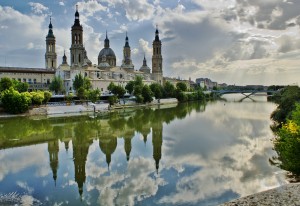Study in Zaragoza, Spain
Study in Zaragoza, Spain

Although sadly overlooked sometimes as a great Spanish destination for tourists, the city of Zaragoza, Spain is an ideal locale to visit—a place where guests can fully experience all the sites and culture that Northern Spain has to offer.
About Zaragoza
Going back to Roman times, the city of Zaragoza has always been an important staging ground in Spain, separating the cities of Barcelona and Toledo, and then later Madrid, when that city became the Spanish capital.
Today, the city of Zaragoza offers visitors a one-of-a-kind Aragon experience at some of the most affordable prices in Spain, largely because the major tourism companies have yet to advertise and exploit the city for all it has to offer.
Zaragoza, which is also called Saragossa locally, is the capital city of the Zaragoza province and also of the Autonomous Community of Aragon, Spain, one of the oldest and most culturally rich regions in the country. Zaragoza lies next to the Ebro River and its tributaries, the Huerva and the Gállego Rivers, are situated roughly in the center of both Aragon and the Ebro basin.
As of the latest census, the city of Zaragoza boasted a population of just over 700,000, making it the fifth-most populous city in Spain. Zaragoza is also the 35th most populous city in the European Union, and the municipality is home to more than 50 percent of the Aragonese population.
Zaragoza hosted the Spanish EXPO in the summer of 2008, a world’s fair focused on water and sustainable development. It was also a candidate for the European Capital of Culture in 2012.
Zaragoza is a city that is famous for its historic folklore, cuisine and many landmarks (see below) and its Fiestas del Pilar are among the most celebrated festivals in Spain.
Things to Do and See in Zaragoza, Spain
If you happen to find yourself in the city of Zaragoza, Spain, you’ll find a countless number of historic and cultural attractions worth visiting. These include:
Palace of Aljaferia
The Palace of Aljaferia, which can easily be mistaken for a later style of fort, is a Moorish-style palace located between the city center in Zaragoza and the main Rail/Bus station. The palace is well-preserved, giving visitors an accurate picture of the city when it was occupied by the Muslim people.
The Palace of Aljaferia is one of the most important Moorish buildings in northern Spain and the setting for the Giuseppe Verdi opera, “Il trovatore (The Troubadour).” The palace is currently the seat of the Aragonese parliament.
Churches of Zaragoza
The churches of San Pablo, Santa María Magdalena and San Gil Abad were all built in the 14th century in Zaragoza, but the towers may be old minarets dating from the 11th century; Other churches, such as San Miguel (14th century); Santiago (San Ildefonso) and the Fecetas monastery, were built in the Baroque style of the day, with Mudéjar (Moorish-style) ceilings of the 17th century. All the churches are Mudéjar monuments that comprise a United Nations World Heritage Site. Other important sights in Zaragoza include the stately houses and magnificent palaces in the city center, mainly built in the style of 16th century Spain. These include the palaces of the Count of Morata or Luna (Audiencia), Deán, Torrero (Colegio de Arquitectos), Don Lope or Real Maestranza, the count of Sástago, the count of Argillo (which today is known as the Pablo Gargallo Museum).

